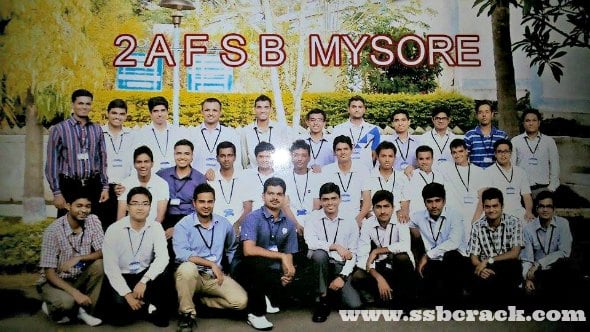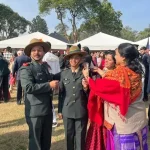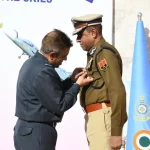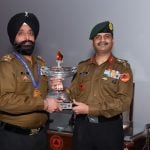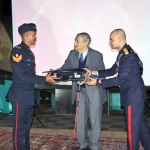Hello, Everybody. I hope this write up helps all the aspirants in getting recommended in their SSB(s). Well, to start it of, I am Azad Hussain, recommended from AFSB 2, Mysore, for AFCAT Jan 2015 course. It was my first attempt, and I really know how hard it was for me to get the relevant information about the whole procedure. SSBCRACK was a useful source to start from where I learned, reading all the experiences. So, I would like to do my bit in inspiring people and giving them an insight of it.
As any curious aspirant, a hundred questions keep giving birth to a hundred new, when you don’t really know clearly about the procedure. I had struggled a lot before my SSB as there were so many people who said different things about it being easy, hard, time pass, biased and stuff. But what I found out at the selection board was totally different. So, please be calm and read the following carefully. I hope it helps at least somebody.
Day 1: The day started early with Air Force vehicles coming in to pick us up from the Railway station at Mysore. By this time a large crowd had formed, with people from different backgrounds and states, flocking in for the selection.
155 was the total number of candidates that stood in a single line. To be frank, I was a little de-motivated and concerned as I looked at so many people. The reason being, everybody was dressed in their best, looking confident and smart. I really gave up hopes as I thought I had no chance whatsoever. Yes, it did give me chills of tension as to how my performance was going to be. But once we were all seated and a light breakfast was offered, we started talking to each other. Then I realized that everybody had some negatives, for example: some were totally clueless about what was going to happen, some were not as confident as they looked, some were weak in communication, etc. So the whole point is not to panic. Like they say, a book can’t be judged by its cover, so are people. You never really know what is cooking in someone’s mind. So be confident and calm. Once I figured this out, I was focused again.
PPDT and GD:
Prior to PPDT there was an aptitude test with two question papers which was pretty easy to solve. Then there was a briefing on PPDT which was given by a Psychologist, referring to the do’s and dont’s. One picture was shown and we were asked to write a story describing what comes to our mind. The picture is blurred and sometimes hard to figure out. The time given is 4 minutes.
TIP: I know a lot of people are concerned about PPDT as it serves an important factor for screening. But, there is no reason to panic and destroy your chances. The ppdt is supposed to test your perception skills and these skills cannot be learnt. I advise everyone not to over-practice PPDT pictures. You are supposed to think on the spot. When you practice, you are actually limiting your mind to just some possibilities. For example, you see a beautiful girl and you want to impress her. So would you go home, write a long note and go back to her or go kick start a conversation with what ever hits your mind? So, develop your personality and work on your positivity. The ppdt story is a mirror of you. And no body can ever teach you, to be you. Trust me the most important thing is to think positive, no matter what you see. A PPDT story requires the following:
- A positive story (even if you see a dead body).
- A main character or protagonist.
- A 3rd person narration. (People often write it as they are in the scene).
- A short term goal of the story that is complete by the end of the story.
- The main character should be a big hearted guy. (Whatever qualities you show in the protagonist is what you are).
So yeah, 4 minutes seem long when you read this but right amidst that hall, and in between so many competitors, they are just seconds. So don’t waste your time staring at the picture. Take a quick look, observe, and start writing. The above points would do. And at the end, even if you couldn’t complete the story, just remember it.
Group Discussion:
Group discussion involves, narrating your story as your turn comes and discussing with others to reach a common story. Here the important part is the “narration”. Being as clear as you can and restricting the shivering would help in speaking fast. One important thing is to be attentive when somebody else is speaking and to look at everybody when your turn comes. As you speak, look at every candidate and be confident. No matter how different your story is; the way you narrate it would make all the difference. Once the narration is complete, the group discussion commences. Always remember, you have to give at least 4 points supporting your story. If it becomes a fish market, be the first one to calm everyone down. It shows that you can take initiative to make people listen to you. And give others a chance to speak , too.
Well, my PPDT story was totally different from the others. While everybody said they saw an athlete, I said he was a social activist. I couldn’t finish my story while writing. But I narrated it confidently. And that is what worked for me, I guess.
So at the end of the screening process, 55 people made it in while the others had to leave.
Day2: Psychological Tests.
These tests play a very, very and very important part in the selection process. And for better ssb scores, I think these test are the best things to focus at. These tests include, TAT, WAT, SRT and SDT.
TAT: A series of 12 pictures are shown, 12th one being an empty slide. The points I mentioned above for the PPDT apply here too. The pictures can be anything. Being totally positive would help a lot in this test. Remember, they don’t want a super hero or star wars story. They want a realistic and attainable approach to things. The stories you write should have a past, a present and a future (the short term goal). Start by describing your character, giving a name, then how he/she might have ended up as shown in the picture and what they did. Here, don’t give any qualities, for example; raj is smart and intelligent, etc.
My first TAT picture had a crowd that surrounded a man, lying on the ground and it looked like he was bleeding from the neck.
My story was; XYZ is a physical instructor of a school. He thought of showing children how to use the first aid kid in case of an emergency as he saw children getting hurt in the playground. So he pretended to be injured and asked the children as to what their precautionary measures would be. School staff was impressed by his efforts and they appointed him as the chief physical instructor.
So yeah, once the first picture is done, you get a good idea and your writing speed increases. Once you are positive, the rest reaches your mind easily. For the 12th slide, think of a story before hand. And here you have the freedom to pen down what you want to. So a good story in 12th slide, reflects you.
WAT: 60 words are shown, one by one, each with a 15second gap to write a sentence on it. WAT is a very simple exercise with easy words. Even here, the sentences are supposed to be positive. Even for words like attack, death, fall, etc. One key factor of these tests is to determine how long you can stay focused, in times of extreme pressure and competition. Restrict from writing big sentences. Be quick and responsive. Don’t keep staring at the word, it is not going to speak to you. Don’t miss out any word. And if you follow these, you can complete all 60 words with ease.
SRT: Situations with blanks are given in a booklet that you need to complete with proper endings. The situations are taken form real life. Always remember, the SRTs can be longer than a sentence. Sometimes it is hard to give an answer in one sentence, so go ahead and write it totally. One more thing is to be realistic and relevant. “I will call my friend and ask for a lift”, “I will fight and save them”, are some of the illogical answers. Remember, these tests are too important for you to be silly. For example, in case, a train you are travelling in is hijacked, you cannot fight with everyone and save the people. Instead, you can close down the windows and lock the doors from inside to save the compartment while calming down people, simultaneously. So be wise when you write the SRTs.
SDT: Self description is something I cannot teach you, in fact, nobody can. You need to describe what your parents think of you, what your friends think of you, what your teachers think of you, what you think of yourself and what you would like to improve in yourself. So yeah, you know yourself better than anybody. Go ahead, describe yourself, but do not exaggerate. Be truthful and confident as you write.
Day 4: Interview.
Personal interview is another important aspect of SSB. Here, an official form the board interacts with you, to know you better, to understand you and to asses your personality. The interviewing official is fully aware of everything that you have done, from your PIQ’s.
PIQ or the personal information questionnaire is a form given on the first day after the screening process. This form serves as an integral part in the interview. You need to fill in your entire details which range from your family background to your schooling, hobbies, sports that you are into, achievements etc. So while filling this form one must be careful and true. The questions asked in an interview are the result of your answers in the PIQ.
So the interview starts of with the Officer asking you rapid fire questions. Be attentive, and in the best of your appearance. The posture in which you sit reflects your personality. As I mentioned before, personality is a key factor. Be neat and tidy. One more thing is to keep your eyes concentrated just on the interviewer and nothing else. And keep smiling. The interview can range from 30minutes to an hour, so you really don’t want to sit with a sad face. Answer straight forward and without any judgment.
Tips:
- Be neat and tidy. (Wearing a tie helps in looking professional).
- Do not panic or fumble.
- Be attentive and responsive.
- Be truthful. (Lying doesn’t help always).
- Brush up your knowledge on current affairs.
- Shed that sad face, sit with a smile.
- Don’t look at the walls. You should look only at the interviewer.
- Don’t use your hand while speaking. Instead, let them rest over your thighs as you sit with your back straight.
My interview was good as I kept smiling and made the interviewer laugh too, at times. And when I got up to leave, I walked up to the table to collect my documents and said, “thank you, sir”. And guess what the reply was, “Thanks Azad, nice talking to you. And yeah, I assume, your zipper is open”. We both laughed as I said, “sorry”, and pulled up my zip, right in front of him. I still laugh when I think of it. But that was a natural reaction; pulling up my zipper. So yeah, things do happen and at times, just go with the flow. Not everything needs to be perfect, remember, we are humans.
Day 5: GTO
The day started with my batch of 8 people, along with other batches, moving to two different rooms for a Group Panning Task. It consists of a model, which depicts a situation that needs to be addressed to. The model is thoroughly explained by the GTO and a paper pad is given to write the possible solution. Once the solution is written, the pads are taken back and the group discussion starts again. This time, the group should collectively form a solution.
Tips:
- Give at least 5 points.
- Give others a chance too.
- If your point seems valid, don’t ignore other solutions offered rather convince them how your point is more important.
- It’s a group task, and being selfish can cost not only you but your whole group, so listen to everybody.
Ground Tasks: (PGT, HGT and Command Task).
All the ground tasks are basically to determine how you move along the group. These group tasks need to be completed by everyone. Being selfish should again be avoided. Listen to each candidate’s ideas. Analyze the possible solutions and keep suggesting new. Support and help other candidates who aren’t speaking up. Not to boast, but during GTO, our batch was the only one to finish all 4 PGTs in the given time. Collective thinking and understanding helped us in moving the whole group as one. For this, our whole batch sat on a bed and discussed how to approach in the GTO, the pervious night.
In command task, avoid being arrogant. I have seen people who command the helpers (the candidates) like they are officers already.
Lecturette: You have to speak on a topic of your choice out of the four given ones. While you speak be confident and keep the GTO bound to your words. Even if the topic is, “My pet”, speak in such a way that everybody is hooked on to your words. One of the ways I adopted was to break my topic into sub points, and elaborating each one as I spoke. This helped me in speaking differently from others and gaining total attention of the Officer.
Individual tasks are easy and can be completed by any one who is fit. Don’t get scared by anyone who tells you to be a total gymnast. I could finish only 6 out of 10. But I chose the difficult ones with more points, so it helped me. And I quote my GTO here, “Don’t worry about the individual tasks, but do your best. When I was selected, I could do only 3”. Don’t be tensed if somebody did more tasks than you.
CONFERENCE: So all the hard work you do in the 6 days ends up to this. THE CONFERENCE, as people call it. One by one, each candidate is called inside a room filled with all the Officials of the Selection Board. Questions about stay and food were asked here. But for some, they ask last minute SRT’s or questions, if some officer has doubts about the selection. But that again happens rarely.
So out of the 55 who got screened in, 6 candidates, including me, were recommended. Yes, the moment your chest number is called out, sky seems to be the limit. For me it is still unbelievable as I write this because I did not prepare anything in specific like others. I just did what I do best, to be me.
In or out, SSB is a great experience altogether. I learned a lot during my stay. I interacted with so many people and made good friends with many. The best thing I would like to point out is the fact that you learn to survive without phones. And that helps to a great extent in exploring yourself.
Thanks a lot everybody for reading this with patience. I know I wrote it a bit long. But I simply did not want to write a SSB experience. I wanted people to get a total insight of how it is. I am hopeful this would help somebody. And if it does, do let me know. I would be glad and immensely happy to be a part of somebody’s happiness.
You can follow me on www.smokeofsulphur.blogspot.in
All the best, friends. And I know I mentioned this a lot of times, but yeah, POSITIVITY is all you need. Do not limit yourself by coaching and stuff. Explore, and be noticed. Thanks.
– Azad Hussain @ www.smokeofsulphur.blogspot.in
 About Azad Hussain: I am Azad Hussain, recommended from AFSB 2, Mysore, for AFCAT Jan 2015 course.
About Azad Hussain: I am Azad Hussain, recommended from AFSB 2, Mysore, for AFCAT Jan 2015 course.
